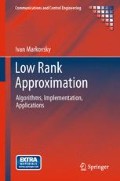Abstract
In Chap. 1, the equivalence between line fitting and rank-one matrix approximation was considered. This chapter extends the equivalence to general linear static and dynamic linear time-invariant data modeling problems. First, three linear static model representations—kernel, image, and input/output—are defined and the connections among them are shown. Then, representations of linear time-invariant dynamic models are defined. Finally, exact and approximate modeling problems are related to low rank approximation problems. In the general case of linear dynamic modeling, the problem is Hankel structured low rank approximation.
… whenever we have two different representations of the same thing we can learn a great deal by comparing representations and translating descriptions from one representation into the other. Shifting descriptions back and forth between representations can often lead to insights that are not inherent in either of the representations alone.
Abelson and diSessa (1986, p. 105)
Access this chapter
Tax calculation will be finalised at checkout
Purchases are for personal use only
References
Abelson H, diSessa A (1986) Turtle geometry. MIT Press, New York
Antoulas A, Willems JC (1993) A behavioral approach to linear exact modeling. IEEE Trans Automat Control 38(12):1776–1802
Beck A, Ben-Tal A (2006) A global solution for the structured total least squares problem with block circulant matrices. SIAM J Matrix Anal Appl 27(1):238–255
De Moor B (1993) Structured total least squares and L 2 approximation problems. Linear Algebra Appl 188–189:163–207
Gabriel K, Zamir S (1979) Lower rank approximation of matrices by least squares with any choice of weights. Technometrics 21:489–498
Kuijper M (1997) An algorithm for constructing a minimal partial realization in the multivariable case. Control Lett 31(4):225–233
Kuijper M, Willems JC (1997) On constructing a shortest linear recurrence relation. IEEE Trans Automat Control 42(11):1554–1558
Kung S (1978) A new identification method and model reduction algorithm via singular value decomposition. In: Proc 12th asilomar conf circuits, systems, computers, Pacific Grove, pp 705–714
Lemmerling P, De Moor B (2001) Misfit versus latency. Automatica 37:2057–2067
Manton J, Mahony R, Hua Y (2003) The geometry of weighted low-rank approximations. IEEE Trans Signal Process 51(2):500–514
Markovsky I, Van Huffel S (2007) Left vs right representations for solving weighted low rank approximation problems. Linear Algebra Appl 422:540–552
Markovsky I, Rastello ML, Premoli A, Kukush A, Van Huffel S (2005a) The element-wise weighted total least squares problem. Comput Stat Data Anal 50(1):181–209
Markovsky I, Willems JC, Van Huffel S, Moor BD, Pintelon R (2005b) Application of structured total least squares for system identification and model reduction. IEEE Trans Automat Control 50(10):1490–1500
Roorda B (1995a) Algorithms for global total least squares modelling of finite multivariable time series. Automatica 31(3):391–404
Roorda B (1995b) Global total least squares—a method for the construction of open approximate models from vector time series. PhD thesis, Tinbergen Institute
Roorda B, Heij C (1995) Global total least squares modeling of multivariate time series. IEEE Trans Automat Control 40(1):50–63
Srebro N (2004) Learning with matrix factorizations. PhD thesis, MIT
Vanluyten B, Willems JC, De Moor B (2005) Model reduction of systems with symmetries. In: Proc 44th IEEE conf dec control, Seville, Spain, pp 826–831
Wentzell P, Andrews D, Hamilton D, Faber K, Kowalski B (1997) Maximum likelihood principal component analysis. J Chemom 11:339–366
Willems JC (1986) From time series to linear system—Part II. Exact modelling. Automatica 22(6):675–694
Willems JC (1987) From time series to linear system—Part III. Approximate modelling. Automatica 23(1):87–115
Willems JC (1997) On interconnections, control, and feedback. IEEE Trans Automat Control 42:326–339
Author information
Authors and Affiliations
Corresponding author
Rights and permissions
Copyright information
© 2012 Springer-Verlag London Limited
About this chapter
Cite this chapter
Markovsky, I. (2012). From Data to Models. In: Low Rank Approximation. Communications and Control Engineering. Springer, London. https://doi.org/10.1007/978-1-4471-2227-2_2
Download citation
DOI: https://doi.org/10.1007/978-1-4471-2227-2_2
Publisher Name: Springer, London
Print ISBN: 978-1-4471-2226-5
Online ISBN: 978-1-4471-2227-2
eBook Packages: EngineeringEngineering (R0)

